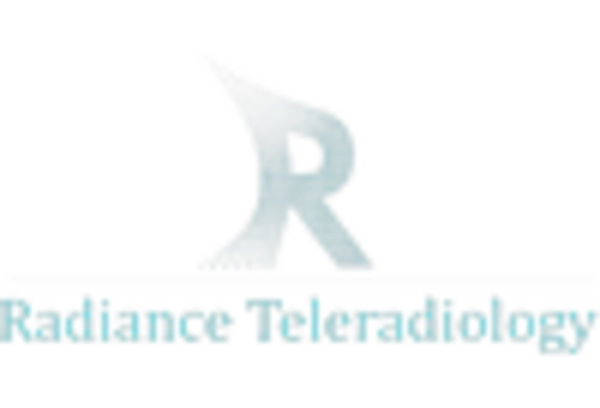Aging Population
Italy's demographic shift towards an aging population is a crucial driver for the teleradiology market. As the proportion of elderly individuals increases, the demand for medical imaging services rises correspondingly. Older adults typically require more frequent diagnostic imaging due to age-related health issues, which can strain traditional healthcare systems. Teleradiology presents a viable solution by enabling remote access to radiological services, thus alleviating pressure on local facilities. Current statistics indicate that over 23% of Italy's population is aged 65 and older, a figure projected to increase in the coming years. This demographic trend suggests a sustained demand for teleradiology services, as healthcare providers seek to meet the needs of an aging population while maintaining efficiency and accessibility.
Rising Healthcare Costs
The escalating costs associated with healthcare in Italy are driving the teleradiology market. As hospitals and clinics face budget constraints, they are increasingly seeking cost-effective solutions to maintain quality care. Teleradiology offers a way to reduce overhead by minimizing the need for on-site radiologists, thus allowing healthcare facilities to allocate resources more efficiently. According to recent data, the average expenditure on healthcare in Italy has risen by approximately 5% annually, prompting institutions to explore innovative solutions. This trend indicates a growing reliance on teleradiology services, which can provide timely and accurate diagnostic imaging without the need for extensive physical infrastructure. Consequently, the teleradiology market is likely to experience significant growth as healthcare providers adapt to these financial pressures.
Integration of AI Technologies
The integration of artificial intelligence (AI) technologies into the teleradiology market is transforming the landscape of medical imaging in Italy. AI algorithms can enhance the accuracy and speed of image analysis, allowing radiologists to focus on more complex cases. This technological advancement not only improves diagnostic capabilities but also increases the efficiency of teleradiology services. As healthcare providers in Italy adopt AI-driven solutions, the demand for teleradiology is expected to rise. Recent studies suggest that AI can reduce diagnostic errors by up to 30%, which is particularly beneficial in a country where timely and accurate diagnoses are critical. The ongoing development and implementation of AI technologies indicate a promising future for the teleradiology market, as it aligns with the broader trend of digital transformation in healthcare.
Expansion of Telehealth Services
The expansion of telehealth services in Italy is a pivotal driver for the teleradiology market. As telehealth becomes more integrated into standard healthcare practices, the demand for remote diagnostic services is increasing. Teleradiology complements telehealth by providing essential imaging services that can be accessed remotely, thus enhancing the overall telehealth experience. Recent data indicates that telehealth usage in Italy has surged by approximately 40% in the past year, reflecting a growing acceptance of remote healthcare solutions. This trend is likely to continue, as both patients and providers recognize the benefits of telehealth. Consequently, the teleradiology market stands to gain significantly from this expansion, as it becomes an integral component of comprehensive telehealth offerings.
Increased Focus on Patient-Centric Care
The shift towards patient-centric care in Italy is significantly influencing the teleradiology market. Healthcare providers are increasingly prioritizing patient convenience and accessibility, which teleradiology inherently offers. By enabling remote consultations and diagnostics, teleradiology enhances the patient experience, allowing individuals to receive timely care without the need for extensive travel. This focus on patient satisfaction is reflected in recent surveys indicating that over 70% of patients prefer remote healthcare options. As healthcare systems in Italy strive to improve patient outcomes and satisfaction, the adoption of teleradiology services is likely to accelerate. This trend suggests a robust growth trajectory for the teleradiology market, as it aligns with the evolving expectations of patients and healthcare providers alike.

















Leave a Comment